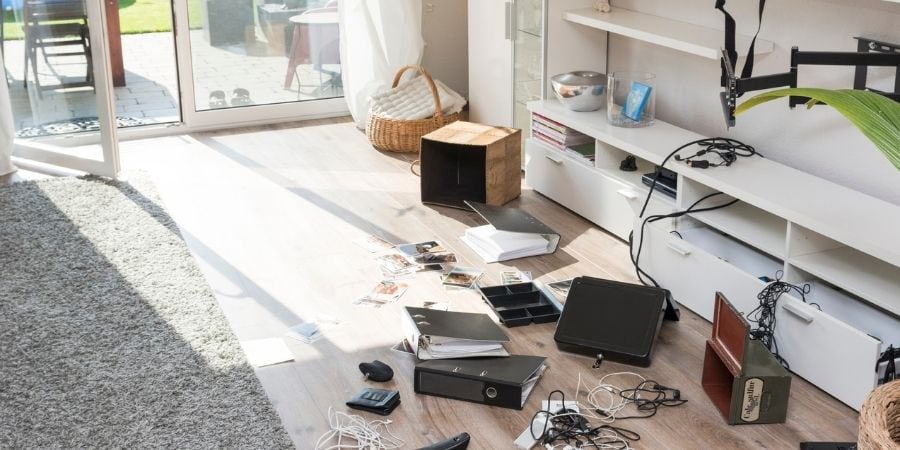Burglaries are crimes of opportunity. According to the FBI, 37.8% of burglaries are considered unlawful entries — This number includes anything from an unlocked door to an open window [1]. While you can reduce the chances of a burglar entering your home by locking doors and windows, there are other things you can do today to further reduce your chances of a burglary.
Which homes do burglars target?
When considering your current home or a neighborhood you’re looking at buying in, there are a few things to think about. Not only should you think about installing an alarm system, or trimming back the hedges, but also think about keeping an eye on burglaries in your area.
Here are some of the top things burglars look for when targeting homes.
Single-family detached homes in the middle of the neighborhood (as opposed to corner units, which are less likely to be burglarized).
Homes next to empty lots or without nearby neighbors.
High privacy hedges, bushes, and walls around the property.
Outdated window and door frames, as well as sliding glass doors or cheap wooden doors.
Packages or mail stacking up on a porch or even recycling left out before collection could indicate you have recently gone out of town.
Homes without a security system are three times more likely to be burglarized [3].
Many burglars reported going back to the same area more than once, so keep an eye on crime in your neighborhood to be proactive in your home safety.
Now that you know what burglars are looking for, here are some ways you can help deter them from breaking into your home.
A home security system with cameras and alarms. It’s important to display alarm signs at both the front and back doors.
When the home uses a deadbolt lock and makes sure that the garage door, windows, and other doors are secure.
A BEWARE OF DOG sign [2].
Close neighboring homes make it easier for a neighbor to spot an unwelcome guest.
Parked cars or running sprinklers, which might tell a thief that someone is home.
Leaving a TV or radio on also signals that the property is occupied.
Outdoor lights, especially lights with a motion sensor.
Keeping your blinds and curtains closed makes it harder for a burglar to scope out your property—whether you’re home or not.
Change your porch light routine. Instead of only turning them off when you’re not home, switch up the days and frequency of the lights.


What attracts a burglar to your home?
While many burglars admit to looking for overgrown hedges or other things that might hide them from view, many of them simply walk in through an open door. Only about 10% of homeowners arm their security system at night, so it’s essential that your alarm is armed before leaving the home or going to bed [3].
Here are some things you can do to make an opportunistic burglar think twice about targeting your home.
Make sure to lock your garage door and deadbolt the front and back doors, as well as other doors (including doggy doors and garden sheds), and each window. Also, consider installing a heavy-duty deadbolt lock to your garage door, too.
When you get an expensive electronic, cut the box into smaller pieces.
If you’re going out of town, consider hiring a landscaping company or having a neighbor mow your grass.
Have a friend or neighbor bring in letters, packages, and mail while you’re on vacation, or put your mail on hold.
Avoid announcing when you’re going out of town on social media; wait until you get back to share those panoramic views.
Don’t leave trash or recycling on the curb, since even empty cans might alert someone that you aren’t home.
Arm your alarm system.
Install window alarms. They could alert you to an intruder or scare away a would-be burglar.
Consider installing privacy glass in sliding glass doors to prevent burglars from peeking into your home.
Get to know your neighbors. Not only will it be beneficial to recognize people in your neighborhood for safety purposes, but they can also keep an eye on your home when you’re gone.
Knowing your neighbors is especially handy If someone attempts a “knock-knock” burglary. You’ll be familiar with the people in your neighborhood and recognize it as suspicious activity.
What are “knock-knock” burglaries?
Burglars often admit to casing homes, pretending to be a neighbor, survey-taker, service or utility worker, or a food delivery driver at the wrong house.
“Knock-knock” burglaries have recently become more prevalent in communities. A burglar might knock on a homeowner’s door to see if you’re home. Sometimes, seasoned burglars use it as an opportunity to case a house, attempting to find out what your work schedule is like, if you own a pet, or even just trying to peek at the property.
A doorbell camera not only allows you to keep an eye on your front door but allows you to respond to someone at your door—even if you aren’t physically home.


What items do burglars look for in a home?
When breaking into a home, there are a few key places that a burglar goes first: the bedrooms and bathrooms, then the drawers, closets, and dressers in each of those rooms.
Where do burglars look for valuables?
The first place most burglars look is the master bedroom [2].
Many burglars then move on to a study, library, or office where electronics are located.
Bathrooms are also popular, where the thief goes through your medicine cabinet.
Various cabinets and drawers throughout the house.
“Everywhere! From the stove and freezer to the fish tank and toilet tank, bookshelves[sic] and in boxes of cereal,” one convicted burglar confessed [2].
Items that are commonly taken during burglaries:
During burglaries, intruders commonly look for portable items with a high resale value, things they can shove into a car and drive away within 10 minutes or less.
Personal information, like last year’s tax statement, credit card bills, or an old passport
Firearms
Jewelry
Prescription medication
Electronics, like gaming consoles, TVs, computers, laptops, or smartphones
Cash
Clothing and designer handbags or furs
Consumable goods, such as alcohol
Household goods, including pots and pans, knives, and kitchen appliances.
[1] [2]
It might surprise you what items a thief might steal, like food or household items, but by following a few tips and tricks, you’ll be one step closer to outsmarting a burglar!
How can you keep your belongings safe?
Long gone are the days where you can hide your valuables in an empty cereal box or dresser drawer. Experienced burglars are already aware of these hiding places, and make sure to go through them before they leave your home. But there are a few things you can do to keep your belongings safe.
Store important documents, firearms, or jewelry in a safety deposit box bolted firmly to the floor or wall or inside a heavy-duty filing cabinet. Make sure to shred old bank statements.
While you can also purchase a bathroom safe for medication, it’s also a good idea to keep any essential pills on hand as you travel.
Keep the serial numbers to your electronics on file. If they’re stolen, having the serial numbers makes it easier to get the items back.
As for phones and computers, many now offer device tracking software that makes them easier to find. Make sure you’ve turned this option on, though!
Home insurance is also a good idea. Take pictures of expensive art or kitchen appliances and store them on an external drive or cloud server for easy accessibility.
Mix up your designer threads with less-expensive clothing and shoes or keep them out-of-site in unmarked boxes.
A formerly convicted burglar, Chris Patterson, also has these suggestions:
Instead of keeping jewelry and heirlooms in a top drawer, place these valuables in a plain box outside the master bedroom, in a guest room, or kids’ room. This makes it harder for a burglar to find your valuables since they focus on the main bedrooms.
Keep tablets, laptops, and phones separate from their charging cords, since they are more difficult to sell without those chargers. A burglar may even opt to leave these electronics if they can’t find the cords quickly.
How do you catch a burglar?
Having a security system in place with an alarm is not only an initial deterrent for someone casing your property, but it can also give you an advantage if thieves decide to break in.
Home security cameras can catch a burglar red-handed, providing visual evidence in a police investigation.
Loud alarms can frighten an opportunistic burglar away, as well as alert you or the neighbors that someone is trying to break in.
Motion-sensing lights can literally shine a light on your property, illuminating the would-be intruders.
A smart lock alerts you when people are coming and going and allows you to arm your security system remotely. You can even program lights to turn on and off for increased home security.
How often are burglars caught?
Even if they leave fingerprints, it can be challenging to figure out if they belong to a family member or the burglar. In the United States, only about 13% of burglars are arrested [3]. Having a home security system can prevent a residential burglary while also recording one if it does occur.
Help protect your home with some help from the security experts at ADT.
Whether someone attempts to break in or gets away with your personal property, a home burglary can be a scary experience. Most burglars want to get in and out quickly without being seen. And many of them are opportunistic burglars, walking right through a patio door or opening an unlocked window.
Many home burglaries are preventable by using defensive practices. Adding an alarm and a home security system and updating locks and windows are a great start to keeping you and your loved ones safe.
[1] https://ucr.fbi.gov/crime-in-the-u.s/2019/crime-in-the-u.s.-2019/topic-pages/burglary
[2] https://www.ktvb.com/article/news/crime/we-asked-86-burglars-how-they-broke-into-homes/277-344333696
[3] http://www.jsu.edu/police/docs/Schoolsafety.pdf
Related Articles:


